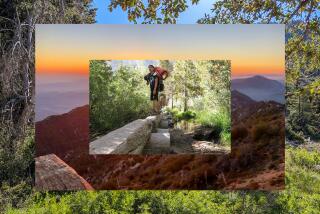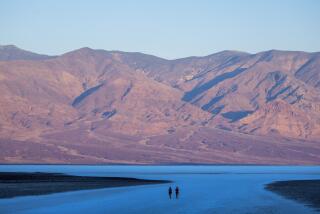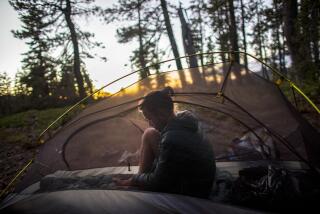Camping’s cold standard
- Share via
Most folks have enough sense to come in out of the cold. And then there are snow campers.
Snow camping is not for everyone. Those who believe a good time requires temperatures of 72 degrees should stay home. Others willing to brave daytime temperatures of 20 to 50 degrees can enjoy some sublime places during a time of year when peace and quiet reign.
“No bears, no mosquitoes and no boom boxes” is what Marc Hertz enjoys most about pitching a tent in the winter. Hertz is an attorney in the San Fernando Valley and an experienced -- and enthusiastic -- snow camper.
He’s also a leader with the Sierra Club’s Wilderness Travel Course, which requires graduating students to survive a weekend of snow camping in the Sierra Nevada.
They snowshoe in, set up camp, snowshoe some more and learn how to build a picnic bench out of snow.
Camping in the white stuff presents unique challenges, but some ingenuity, along with advances in camping equipment and winter clothing, can help meet those demands, providing comfort in the snowy wilds -- even when nighttime temperatures plunge close to zero.
The key to enjoying these conditions -- and staying alive -- is to keep warm and dry. Waterproof boots, pants and an outer shell are essential, Hertz says.
Other musts include gloves and a fleece or knit cap -- better yet, a face-covering balaclava, which is a knit or neoprene hood, for more coverage.
Hertz discourages any type of cotton clothing, preaching the travel-course mantra that “Cotton kills.” A sweaty cotton T-shirt will cool the body in summer’s heat, but it’s slow to dry -- an enemy that can lead to hypothermia in winter.
Other necessities include a sleeping bag rated to zero with a pad beneath it to insulate against the snow. Some even use two pads -- a closed-cell foam pad topped with an inflatable one. Use a silk sleeping bag liner for even more warmth.
Snow campers employ a few toasty tricks to beat the cold. One is to stick a Nalgene bottle filled with hot water in a wool sock and toss it in the bottom of the sleeping bag. It’s also a good idea to eat plenty of high-calorie foods, which help keep the body warm.
For shelter, a four-season tent is tops. It’s bigger and heavier, made to withstand snow, and has less mesh than a summer tent. Bring extra fuel for cooking, because it takes longer for water to boil in cold weather.
Where is the best place to snow camp?
Many winter campers snowshoe, cross-country ski or snowmobile into the backcountry on routes that follow their favorite summer hiking trails.
Popular jumping-off places include Rock Creek Canyon in the Eastern Sierra, Mammoth Lakes Basin near Tamarack Lodge, and closer to L.A., spots in the San Gorgonio Wilderness. Some ride the Palm Springs Aerial Tramway and hike into Mt. San Jacinto State Park.
The key is to have a good map, navigation skills and to consult with rangers ahead of time about the best routes and the potential for avalanches.
First-time winter campers shouldn’t overextend themselves, advises Matt Patwell, manager of the REI store in Arcadia.
“You’re dealing with the elements rather than the trek in,” he says. Settle for a several-mile snowshoe trek rather than a 20-mile slog.
Snow campers may be surprised to find that it isn’t the brush with death they may expect. It takes some effort and planning, but it also can be -- as Hertz insists -- fun.
More to Read
Sign up for The Wild
We’ll help you find the best places to hike, bike and run, as well as the perfect silent spots for meditation and yoga.
You may occasionally receive promotional content from the Los Angeles Times.






